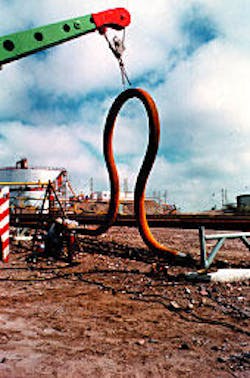Liner rehabs water injection lines in Argentine oil field
A polyethylene liner rehabilitated corrosion pitted, 6-in. carbon steel water-injection lines in the La Ventana oil field, Mendoza province, Argentina. The lines had been in continual use for 30 years, according to ASTRA Repsol-YPF SA, operator of the waterflood.
The Swagelining process allowed the injection pipe sections to be welded together without harming the liner, says Nortek, the Buenos Aires Swagelining licensee.
Project design
Gustavo Palmas, chemical engineer for Repsol-YPF, says that the La Ventana project required a special design because the injection lines were mostly above ground, transported liquids between 167° and 176° F. at an average pressure of 2,100 psi, and had line temperatures that could fluctuate between 32° F. to over 175° F. in a matter of minutes.
To prevent line breakage because of thermal expansion and contraction, the work inserted new omega-shaped lined pipe at 300-yard intervals (Fig. 1).
The omega-shaped sections consist of 30 ft of new steel pipe equipped with WeldLink fittings (Fig. 2) and lined with polyethylene pipe. The omegas were welded into the line after the sections between them were lined and equipped also with fittings. The result was a continuous line with all welded joints and no flanged fittings.
The work started in March 2001, and through April about 5,000-ft of 6-in. line had been finished, according to Nortek.
Claudio Lopresto, president of Nortek, says that the process rehabilitated the injection line to a good-as-new condition at a fraction of the cost of new replacement pipe.
Swagelining process
Nortek says the British gas industry developed the Swagelining process for rehabilitating its gas lines, but now the process has been used successfully worldwide to protect more than 625 miles of pipe ranging from 3 to 48-in. OD. Applications have included pipe used for transporting gas, oil, water, forced sewer, etc.
The process allows the polyethylene liner to be pulled easily through the host pipe by first passing it through a die (Fig. 3) that temporarily reduces the liner OD, which is slightly larger than the ID of the pipe to be lined.
The polyethylene liner begins to return to its original diameter once the pulling force stops, and within hours, it is pressed tightly against the inside of the host pipe, according to the company.



